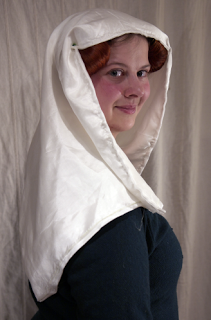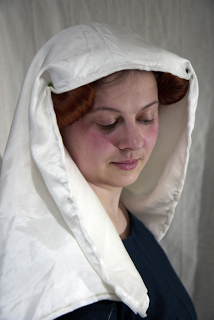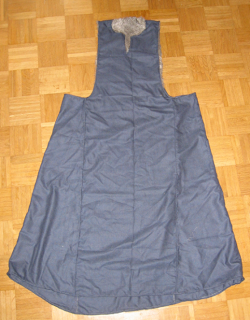Any craftsperson will tell you that tools are important. In fact, if you are reading this blog, I'd be surprised if you did not know yourself that a good needle makes for better stitching than a bad and crooked one, and that a smooth-running spindles, scissors, shears or what-have-you will help you have more fun and less stress when working.
craftsperson will tell you that tools are important. In fact, if you are reading this blog, I'd be surprised if you did not know yourself that a good needle makes for better stitching than a bad and crooked one, and that a smooth-running spindles, scissors, shears or what-have-you will help you have more fun and less stress when working.
While getting pins and needles made from copper alloy is very easy today, compared to the situation only a few years ago, there are more problems waiting for the unsuspecting dabbler in textile arts who ventures into lesser known territories. Like netting. It can be incredibly hard to get a proper netting needle nowadays.
When I first started learning how to net, I searched and searched for a netting needle. The results? Zero, nil, zip. But I wanted to net!
So first of all, I tried with a needle. You can use very little thread with a normal sewing needle, plus the chance of pricking yourself is very high. Not good at all. Even nastier, because a pricked finger will heal: There was a good chance of hitting a thread with the tip of the needle (I was really stupid and used a sharp sewing needle), thus sewing into the net and not knotting.
The next step was trying to make a simple makeshift netting needle by winding two pieces of wire together, forming the ends into netting needle shaped ends. This was better, but not much: The thread kept inserting itself between the two wires, and the makeshift thing had a tendency to bend, twist, and fall apart. I needed a proper netting needle.
So I whined and begged until I got a netting needle made from a hobby metalworker, made of thick copper wire. I had to twitch it a little, and it would only serve for rather large mesh sizes, but I had a netting needle that was actually useable. Hooray! It was much too short for significant lengths of thread, though, and rather hard to wind on and off. But at least it worked. Some time later, I tried to make one myself, which was also of the rather-crude-but-working sort.
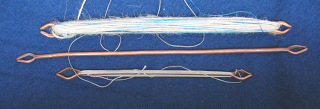
Imagine my happiness when I found out that a proper modern company still manufactures netting needles, sells them via normal sewing shops (though they had to order it) and cheap, too! And with three gauges thrown into the packet! I ordered one at once.
Believe me: it is a good thing this was so cheap. You do not want to buy this. It is so crudely made that I laugh about myself every time I see it. I actually did try the "needles" once. Here is pictorial evidence for you:
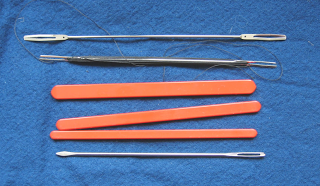
Frankly, they are a bad joke if you are going for medieval-style netting. The material is very cheap and you can see that they are also cheaply made - no wonder, since they have a retail price of about 7 Euros. The shanks at the ends bend easily, they are much, much too thick and will catch the threads of the net much better than sliding through the mesh. If bent together too much, winding and unwinding is hard and abrasive on the thread; if there is a gap between them wide enough for easy winding, the tip is even wider and bulkier. Well, maybe they work if used with the "gauges" that accompany them (plastic sticks), which will result in mesh sizes of approximately 8 to 15 millimetres. Which is rather... huge. I would not recommend buying them, unless you have no other choice whatsoever (read: unless there is nobody at all in your acquaintance that you could beg until he makes you a crude-but-workable netting needle).
... to be continuedtomorrow on Monday. (This is what happens when you don't keep track of what weekday it is.)
While getting pins and needles made from copper alloy is very easy today, compared to the situation only a few years ago, there are more problems waiting for the unsuspecting dabbler in textile arts who ventures into lesser known territories. Like netting. It can be incredibly hard to get a proper netting needle nowadays.
When I first started learning how to net, I searched and searched for a netting needle. The results? Zero, nil, zip. But I wanted to net!
So first of all, I tried with a needle. You can use very little thread with a normal sewing needle, plus the chance of pricking yourself is very high. Not good at all. Even nastier, because a pricked finger will heal: There was a good chance of hitting a thread with the tip of the needle (I was really stupid and used a sharp sewing needle), thus sewing into the net and not knotting.
The next step was trying to make a simple makeshift netting needle by winding two pieces of wire together, forming the ends into netting needle shaped ends. This was better, but not much: The thread kept inserting itself between the two wires, and the makeshift thing had a tendency to bend, twist, and fall apart. I needed a proper netting needle.
So I whined and begged until I got a netting needle made from a hobby metalworker, made of thick copper wire. I had to twitch it a little, and it would only serve for rather large mesh sizes, but I had a netting needle that was actually useable. Hooray! It was much too short for significant lengths of thread, though, and rather hard to wind on and off. But at least it worked. Some time later, I tried to make one myself, which was also of the rather-crude-but-working sort.

Imagine my happiness when I found out that a proper modern company still manufactures netting needles, sells them via normal sewing shops (though they had to order it) and cheap, too! And with three gauges thrown into the packet! I ordered one at once.
Believe me: it is a good thing this was so cheap. You do not want to buy this. It is so crudely made that I laugh about myself every time I see it. I actually did try the "needles" once. Here is pictorial evidence for you:

Frankly, they are a bad joke if you are going for medieval-style netting. The material is very cheap and you can see that they are also cheaply made - no wonder, since they have a retail price of about 7 Euros. The shanks at the ends bend easily, they are much, much too thick and will catch the threads of the net much better than sliding through the mesh. If bent together too much, winding and unwinding is hard and abrasive on the thread; if there is a gap between them wide enough for easy winding, the tip is even wider and bulkier. Well, maybe they work if used with the "gauges" that accompany them (plastic sticks), which will result in mesh sizes of approximately 8 to 15 millimetres. Which is rather... huge. I would not recommend buying them, unless you have no other choice whatsoever (read: unless there is nobody at all in your acquaintance that you could beg until he makes you a crude-but-workable netting needle).
... to be continued




